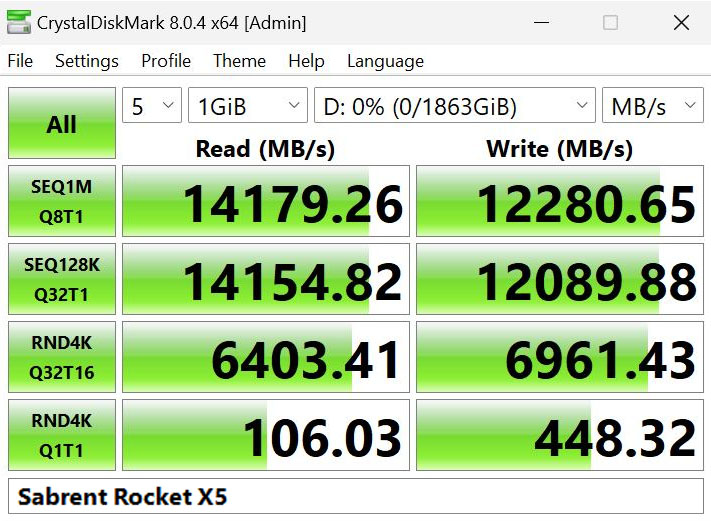Sabrent Rocket Prototype Gen 5 SSD Hits 14 GBps, Could Be World's Fastest
But Sabrent wants even more.

When Sabrent earlier this year announced plans to build a PCIe Gen5 SSD with a read speed of 14 GB/s, we were impressed. Today Sabrent sent out a screenshot with proof that its upcoming Rocket X5 can achieve such a level of performance and even said that it is working to achieve even higher speeds to topple the best SSDs currently available.
Sabrent's Rocket X5 can hit sequential read speeds of 14,179 MB/s and sequential write speeds of 12,280 MB/s in CrystalDiskMark. As for random performance, Sabrent's prototype drive can hit 1.56 million 4K read IOPS and 1.669 4K write IOPS, comparable to high-end enterprise-grade SSDs.
Speaking of enterprise-grade SSDs, we are talking about Samsung's PM1743 PCIe 5.0 x4 SSD, which achieved approximately 13.8 GB/s throughput with Intel's Alder Lake processor in the IOMeter benchmark in late 2021. Apparently, Sabrent can reach even higher speeds with its Phison PS5026-E26-based drive, albeit by using very fast 3D TLC NAND with at least 2400 MT/s interface.
"The new Rocket X5 is still in the tunning process, and we expect performance to improve even better," a statement by Sabrent reads. "This still needs to be a finished product, but we are moving forward with the tech we have at hand now. To name a few items, many things can change, including the name and label and the heat sink. As we work with Phison very closely, new tech is on the way, and Phison assists us in pushing what we have now to achieve groundbreaking results."
Sabrent said it had conducted experiments with various thermal solutions aimed at keeping these extreme drives cool. The company indicated that the current thermal solution is specifically tailored to cool these next-gen SSDs efficiently, and its fan does not produce any high-frequency noise.
"Stay tuned to Sabrent for news on our other top-performing products as we approach the release," the company said. "Our test lab is very busy these days with many new groundbreaking products we will release soon."
Get Tom's Hardware's best news and in-depth reviews, straight to your inbox.

Anton Shilov is a contributing writer at Tom’s Hardware. Over the past couple of decades, he has covered everything from CPUs and GPUs to supercomputers and from modern process technologies and latest fab tools to high-tech industry trends.
-
TrojanHorseOfDoom This is getting ridiculous. We're at the point where this is achieving greater bandwidth than the Wii u's memory interface which topped out at 12.6 GB/s (dual channel DDR3 800) you run 4 of these in RAID 0 (bad idea btw) and you get comparable bandwidth to dual channel ddr4 3200Reply -
Amdlova Reply
A that speed it's like a drag car. One push one rebuild :)-Fran- said:Do the IC's and memory modules last more than a sparkler? :D
Regards. -
Amdlova Last build I have uses a adata blade s70... now I have a optane 900p 280gb. It's give 2000mb/s but that it's fast super fast.Reply
With ssd I feel small stuttering on system with optane don't have. And that thing will last forever. -
Li Ken-un Reply
2,000 MB/s is not how Optane works to make your system not stutter. You can find NAND-based SSDs that do 12,000 MB/s on the market now and which can muster 1.5 million IO/s.Amdlova said:I have a optane 900p 280gb. It's give 2000mb/s but that it's fast super fast.
With ssd I feel small stuttering on system with optane don't have. And that thing will last forever.
The key advantage of Optane is the latency. It’s the only PCIe storage on the market that can sustain 320 ~ 460 MB/s random 4 KiB I/O at queue depth 1. It doesn’t matter what the generation. I’ve found P5800X to perform about the same as the older P4800X doing QD1 I/O. NAND has been behind by an entire order magnitude in this respect and it still is. That’s probably why you perceive stuttering.
If Intel had chosen to kneecap their Optanes by putting them behind an SATA interface… I would still buy them. After all, the random I/O latency is the unique selling point of the media—not sequential throughput or IOps. Although the P5800X manages an impressive 5 million IOps and could probably do more if not limited by the host. -
RichardtST As long as the fan has a built-in temperature sensor so it only has to run when needed, I'm game.Reply
